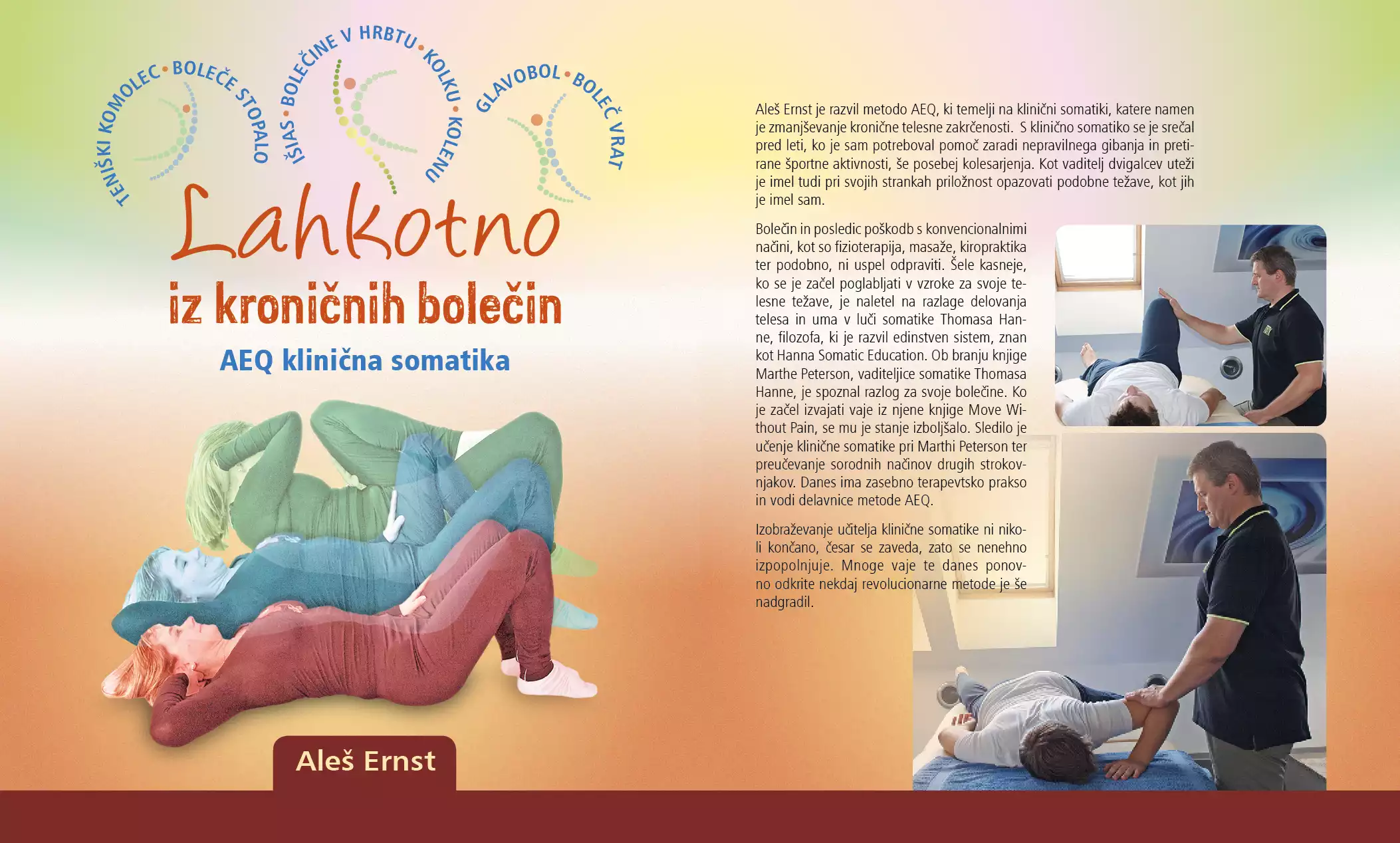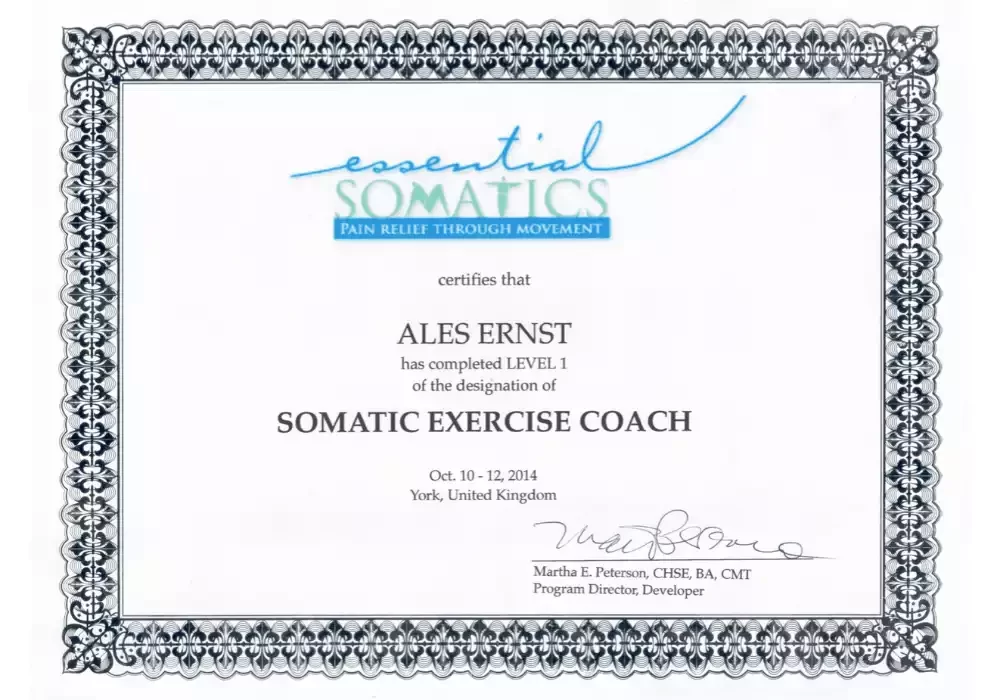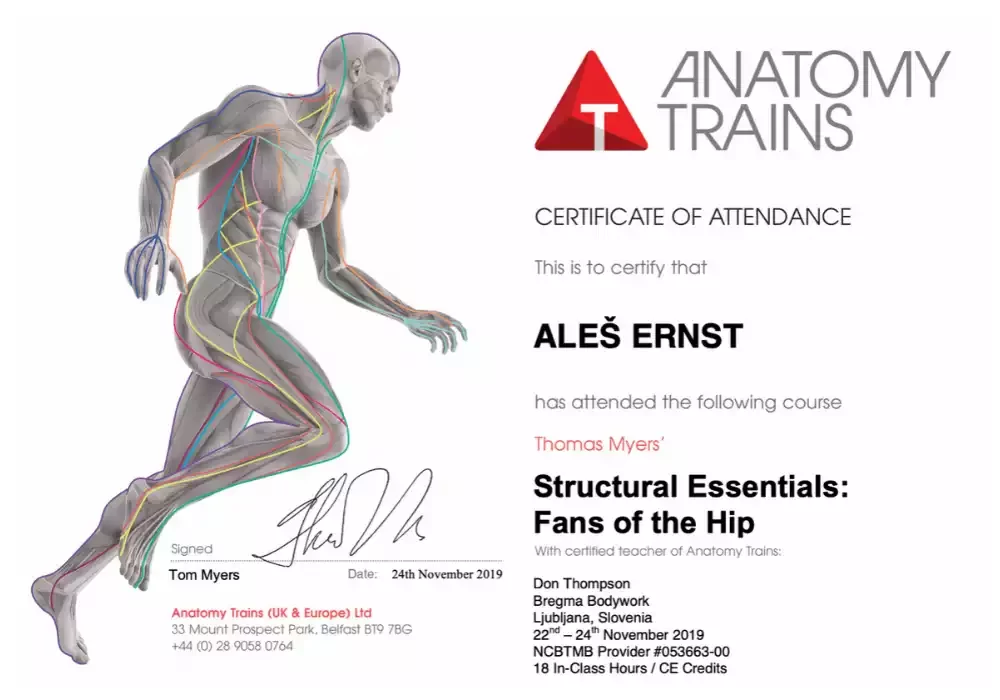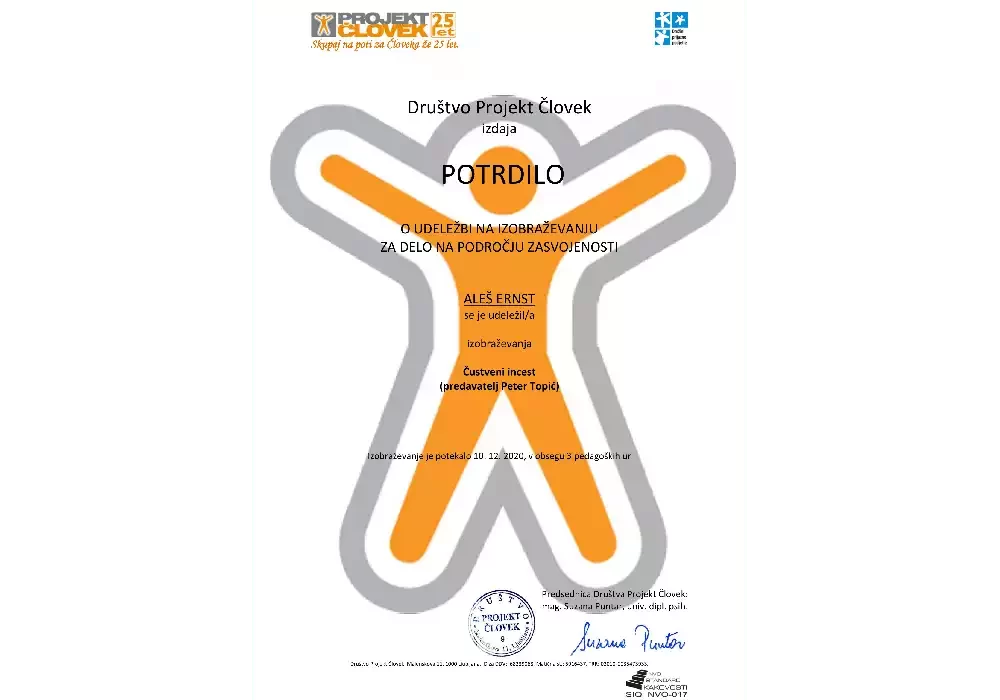ALEŠ ERNST
author of the AEQ method® and AEQ breathing®
author of the book “Lahkotno iz kroničnih bolečin”
Home » Author of the method » Aleš Ernst
My name is Aleš Ernst, and I was born in 1971. I live in Brežice with my partner Vesna and my two sons, Klemen and Domen. In my youth, I had considerable difficulties with movement, stability, and flexibility due to my underdeveloped right side of the body. This greatly impacted me because my peers were making fun of my disability, causing me to isolate myself. I spent a lot of my free time reading books. The need to read also stemmed from the environment’s attitude towards me during this period, as I often heard and felt that nothing would come of me because I was slow, clumsy, and, on top of that, careless. On the other hand, the absence of my father, who left my mother when she was still pregnant with me, also had a strong impact on me. Due to my lack of self-confidence, I only learned to ride a bike at the age of fifteen, but I soon began cycling intensively and participating in cycling marathons.

Even though I had plenty of work in my company, I spent my free time actively cycling, running, swimming, and lifting weights. Today I understand that I was forced to do this by the hatred I developed due to my helplessness in childhood. This helplessness persisted into adulthood, and I was able to overcome it only by using the AEQ method. The hatred I had was a strong enough source of energy to build a successful business from scratch and train way too much while working. Over time, excruciating pain developed in my left hip. Said pain stopped me from cycling and made me focus on lifting special weights called kettlebells. I received the appropriate certificates and taught my clients about appropriate work and movement under pressure. At the same time, I began to notice the shortcomings of my own mobility. The pain in my hip, which initially subsided when I switched to another sport, returned over time. That’s why I sought medical help, but neither the explanation of the causes of the excruciating pain nor the offered solutions convinced me. Physical therapy, muscle strengthening, elastic band work, massages, chiropractors, and hours of meditation had no significant effect. I just had to accept the pain as a constant in my life, but I never came to terms with it.
From the age of 23 to 39, I had a stressful job with a lot of responsibilities. I worked a lot, and relaxing in the mornings, evenings, weekends and holidays mostly meant cycling. Looking back at this era of my life with my current knowledge, I know that I couldn’t afford myself a moment of peace or relaxation – or, worded differently – I wasn’t in contact with myself, my soma. The ten-to-fourteen-hour work schedule has impacted my health. The result was constant and increasingly severe pain in both my left hip and leg and no time to improve the efficiency with which I used my time, energy, and emotions. It was not only my body that suffered but also my family.
In 2003, due to the premature death of Vesna’s mother, I began to realize that well-being and health are not taken for granted, which prompted me to read literature and books related to the functioning of the human body, mind and brain and ways to change the shape and functioning of the body. Vesna delved more and more into the non-physical part of man and studied the functioning of feelings, emotions, psychology, education, and behavior.
When a person has to exit the highway and drive steadily and slowly on a dirt road he is confused and insecure.
Almost stressed out, even though we’ve survived millions of years
and developed in a hostile environment.Aleš Ernst
By 2011 I have studied plenty of literature about the human body and ways to improve its functioning by eliminating the problems and imbalances within. This partially helped me reduce my chronic problems, but I never completely eliminated them. I never achieved peace and relaxation in both myself and my surroundings. Despite my great desire and hard work, my condition only worsened, forcing me into hopelessness and forfeiting to time and life.
Only later, when I began to delve deeper into possible causes for the inability to eliminate pain, I stumbled upon the explanations on the body and the mind by Thomas Hanna. I found a possible solution to my problems without invasive interventions in the body. Reading Martha Peterson’s book and corresponding with her, I slowly understood the real reason for my shorter right leg and why I have such persistent pain in my left leg. After just a few days of doing the basic exercises, I noticed an incredible improvement. I wanted more. I studied clinical somatics under Martha Peterson and successfully completed the course, while at the same time, I also studied with other experts in related fields. A somatic view of the way the mind and body function gradually allowed me to find a better explanation for the causes of the problems that plagued me. On the other hand, I realized what my family was telling me when they warned me about the unwanted consequences of my decisions and actions.
A better solution means to do more, or at least the same amount with less effort (energy).
In other words: think twice, do once.
Like turning from the highway to the driving skills polygon.Aleš Ernst
With the help of somatics, I realized that we are more than only physical bodies and that we spend days without ever thinking about our mental health. I realized that I would never have allowed anyone to treat me the way I treated myself. I began to understand what Vesna was trying to tell me. That’s why I slowly adopted a different view and behavior, which consequentially affected my movement.
Four years of training as a teacher of clinical somatics gave me enough breadth and depth of understanding of somatics that I could successfully use to help clients who were looking for a solution to chronic pain and joint and skeletal diseases. The thousands of clients I have taught clinical somatics to understand why they suffer from chronic pain and the thousands of active processes with them have opened up the possibility for me to determine what works in clinical somatics and, at the same time to discover where clinical somatics has deficiencies that prevent the holistic and long-term impact of the received knowledge and feelings on the client for the permanent elimination of chronic conditions.
Somatics gave me the opportunity to learn about a different view and attitude within myself. I gradually realized that I used to think I was more of a machine than a human. I looked at my problems the same way as the ones I fixed at the service station on broken bikes because this approach was close to me, and I mastered it very well. But unfortunately, it didn’t go as I imagined.
I, therefore, dedicated the period after 2011 to the study of somatic approaches and thinking, all the while teaching clinical somatics. To all this, I added the knowledge I had already learned in connection with what I was currently learning and simultaneously added Vesna’s views. In the meantime, I observed reactions and effects from clients. We gradually strengthened the new model of thinking, which has matured into a holistic approach over the years. We called it the AEQ method (AEQitas). Over time, we realized the limitations of the explanation that only sensory-motor amnesia is responsible for chronic conditions while at the same time developing the concept of emotional maturity as those values and abilities that affect all areas of our lives and, above all, determine how we will live.
Emotional maturity, according to the AEQ method, reveals more and more vividly and usefully in which areas we’re okay and in which areas we aren’t. It is much easier to understand that we aren’t sufficiently emotionally mature and efficient in a certain area so that we could solve more problems than creating them. If we cannot do this, we are increasingly helpless in this part of life, which forces us to develop sensory-motor amnesia, sensory-motor alienation, and sensory-motor illusion. From the thousands of clients I have taught the AEQ method, I have received confirmation of the concept, which enabled them to gradually eliminate chronic conditions without exception. But this was achieved only by those with the determination, dedication, and patience necessary to gradually and consciously change their behavior, respecting the rules by which the conscious, subconscious, autonomic nervous system and body work.
The further development of the AEQ method was determined by covid-19, which basically changed the lives of the majority of people overnight. Such extreme events always reveal much more depth than can be revealed in normal times. It was the corona that gave Vesna the idea of online programs. I used to have a very strong aversion to all of this. I was convinced that learning the AEQ method required personal contact, so I never favored online learning. The change in my attitude towards online learning occurred at the moment when, due covid lockdowns and restrictions, I was teaching more and more people online because it was impossible to do otherwise.
That way, I was pushed into learning, developing, and accepting a more and more efficient way of working with my clients, which wouldn’t have been possible without Vesna’s guidance. I gradually moved from multi-hour workshops to daily programs that span over multiple weeks, which caused the biggest changes in clients up to that point. It took us quite a few months to figure out why online programs help to eliminate chronic conditions more efficiently than the approaches I used to teach the AEQ method before the pandemic.


In 2014, I decided to write a book on clinical somatics. I already had plenty of experience and positive feedback from my clients, so I felt that the book would be well written to help those who cannot reach me. In a year of content creation, the book ‘’Lahkotno iz kroničnih bolečin – klinična somatika” was created, which contained a detailed explanation of the condition of sensory-motor amnesia and the reasons and causes of the most common chronic conditions that I encountered in my work. I designed the exercise descriptions for the most optimal learning experience without the presence of a clinical somatics teacher. I self-published the book in 2015 and supplemented and reprinted it in 2018. I also translated the book into Croatian. The response of the readers was positive, because with the help of the book, many readers alleviated chronic conditions and correctly used clinical somatics to improve their well-being.
As I developed the AEQ method, I also began developing teacher seminars, which would give students the required knowledge to teach the method themselves. It didn’t take long before some clients recognized the usefulness and effectiveness of my approach and wanted to learn more so that they would become teachers themselves. It took me a few years to feel professional and mature and, above all, responsible towards the education of teachers of the AEQ method, even though Vesna and I knew from the beginning that I would not be able to help clients on my own and be the only one teaching AEQ. Thus, I have been training new AEQ method teachers for the seventh year, and during this time, I have trained more than 120 of them. Most of them regularly teach and help others heal chronic conditions while at the same time improving themselves, strengthening their self-awareness and understanding of the impact of physical laws on life. AEQ forever changed the lives of all who attended the seminars.
In 2019, I studied human breathing well enough to add a new branch to the AEQ method tree called AEQ breathing. This helps people understand and modify their breathing as the only vital function over which everyone can have a conscious influence. I noticed long ago that almost all clients breathe illogically and do not adjust their breathing to the actual state of the environment they are in, and despite a much more relaxed body after a session, their breathing isn’t slower, calmer and deeper. After many years of studying breathing and combining the findings of various experts with a specific understanding of the life processes characteristic of the AEQ method, AEQ breathing was created. It has been proving for three years now that a holistic approach to breathing, which includes states of sensory-motor illusion and insufficient emotional maturity for effective breathing, is among the most effective and allows for the permanent regulation of the vast majority of breathing problems that are marked as incurable.
I formed an understanding of the role of emotional maturity and efficiency, which began to become clear in 2017 and finally matured after the introduction of online programs into AEQ relationships. Since then, there has been an increasing need for an adequate explanation and learning of the role of relationships in life. The aim is to teach clients why their current relationships aren’t satisfactory for them and where the inappropriate patterns that form and maintain such relationships come from, even though they are harmful and unnecessary. AEQ increasingly helps regulate relationships between partners, parents, and children, ultimately also in the business or sports world. Just as the AEQ Method and AEQ Breathing enable a change of attitude towards yourself, AEQ Relationships enable continuous improvement and increase the ability to have more effective and better relationships with others.
In 2021 and 2022, we conducted a scientific study on the impact of learning the AEQ method on online programs on chronic pain. 749 participants of online programs took part in the survey. The research showed a statistically significant difference in medically unexplained conditions (chronic pain) before and after participation in the AEQ-programs. So, on average, the level of chronic pain decreases, which is the main goal of participants who have been suffering from chronic pain for a long time. The effect of participation in AEQ programs is visible after one month, three months, six months as well as after nine months. Everything that Vesna and I developed was confirmed in an objective and measurable way. The other teachers of the AEQ method in Slovenia and Croatia also achieve equally good results.
The AEQ system has become developed, regulated, and stable enough for it to gradually spread abroad, as the need for an approach that can effectively explain and enable predictably effective influence on chronic conditions is growing. The future development of the AEQ approach will be focused in this direction. In any case, there is still plenty of room for improvement in all three AEQ branches.








Finally, I would like to mention the authors whose work enabled us to develop gradually and at the same time, enabled AEQ to be at the level it is at the moment:
- Adrian P. Kezele
- Agatha Christie
- Alan Lakein
- Albert J. Bernstein
- Alexandra Katehakis
- Alexandre Lowen
- Alice Miller
- Andrej Dekleva
- Andrej Grabnar
- Angela Elliot
- Anne Weiss
- Antonio Damasio
- Aristotel
- Arthur Conan Doyle
- Artour Rakhimov
- Belisa Vranich M. D.
- Blair Singer
- Bruce H. Lipton
- Bryan Au
- Carl Stough
- Carl Young
- Carola, Speads
- Caroline Williams
- Christoper Gilbert
- Clinton Ober
- Collen Patrick-Goudreau
- Court Saldo
- Dalajlama
- Dalibor Petrinič
- Dan Brown
- Dan Brown
- Dan John
- Daniel E. Lieberman
- Daniel Imhoff
- Daniel M. Ammato
- Dante Alighieri
- David Hopper
- David Wolfe
- Deb Shapiro
- Dinah Bradley
- Douglas Adams
- Dr. Joseph Murphy
- Edvard Yu
- Eliot Jurist
- Elissa Epel PhD
- Elizabeth Blackburn PhD
- Emmanuel Todd
- Ester Hicks
- Felicty Lawrence
- Franc Škerlj
- Frank Forencich
- Gabor Mate
- Garry Cook
- Gary Taubes
- Geoff Neupert
- Gyorgy Geregely
- Hector Prestera PhD
- Heinz Kohut
- Helen Foster
- Henri F. Ellenberger
- Inna Khazan PhD
- Ivan Cankar
- Ivan Tavčar
- James Earls
- James F. Scheer
- James Jones
- James Nestor
- Janez Jalen
- Jared Diamond
- Jayne Couidon
- Jean Piagget
- Jennifer Cornbleet
- Jerry Hicks
- Joanna Blythman
- Joe Dispenza PhD
- Joe Navarro
- John Berardi PhD
- John C. Parkin
- John Kelly
- Jordan B. Peterson
- Jordan Maerin
- Joseph E. LeDoux
- Josip Jurčič
- Jožica Veble
- Jules Verne
- Julie Rodwell
- Justin Rosales
- Kenneth Jay
- L. Ron Hubbard
- Lance Armstrong
- Leo Babauta
- Leon Chaitow
- Lisa Fledman Barret
- Logan Christoper
- Lou Paget
- Louise M. Wisechild
- Luise Hay
- Mark R. Levin
- Martha Peterson
- Martin Kihn
- Marty Gallager
- Mary Target
- Matthew Rogerss
- Matthew S. Bennett
- Matthew Walker
- Max Horkeimer
- Maxick
- Melanie Klein
- Meti Brus
- Michael Easter
- Michael Moore
- Michael Pollan
- Michel Montignac
- Miško Kranjec
- Mojca Logar
- Moshe Feldenkrais
- Nan Wise PhD
- Napoleon Hill
- Natalija Princi
- Norman Doidge
- Ori Hofmekler
- Osho
- Pamela Druckerman
- Patrick McKewon
- Paul, Ekman
- Paulo Coelho
- Pavel Tsatsouline
- Perry Marshall
- Peter A. Levine
- Peter C. Gotzsche
- Peter Fonagy
- R. Louis Schultz PhD
- Richard J. Johnson M. D.
- Rippetoe & Kilgore
- Robert B. Cialdini PHD
- Robert Greene
- Robert Spalding
- Ron Kurtz
- Rosemary Feitis DO
- Roy Herbert Jarrett
- Rudolph Ballentine M.D.
- Scott Cuidon
- Scott Sonnon
- Sergei Boutenko
- Severin Lipovšek
- Shane O'Mara
- Sharon Moalem
- Sharon Moalem PhD
- Sigmund Freud
- Simon Baron-Cohen
- Simota Seidzi
- Snežana Radojičić
- Stanley Keleman
- Stefan Bonner
- Stephen Hawking
- Stephen Rollnick
- Stephen T. Sinatra M.D.
- Steven Pressfield
- The Holy Bible
- The Arbinger Institute
- Theodor w. Adorno
- Theron Q. Dumond
- Thomas Hanna
- Thomas Verny M.D.
- Thomas W. Myers
- Timothy Ferriss
- Tizaiana Alipo Tamborra
- Tom Venuto
- John Douillard
- Tom Woodward
- TQ Dumont
- Vadim Zeland
- Verlyn Klinkenborg
- Victoria Boutenko
- Wallace Delois Wattles
- Wheeler Del Torro
- Wilhelm Reich
- William R. Miller
- William Walker Atkinson
- Wim Hof
LOCATION
GPS:
degrees (DD.dddddd°) 45.912765, 15.592775
degrees and minutes (DD°MM.mmm’) N 45 54.766, E 15 35.566
degrees, minutes and seconds (DD°MM’SS.s”) N 45 54 46, E 15 35 34
Customers guided by GPS navigation should pay attention so that it doesn’t take you to Dobova (there is a street with a very similar name). If your GPS is giving you trouble, insert the following adress: Ulica Kozjanskih Borcev 18, Brežice (a restaruant near us). Google and Apple maps find is without difficulty, however, Garmin might have some trouble 🙂

Aleš Ernst, clinical somatics, and differentiation s.p.
Ulica bratov Gerjevič 1A,
8250 Brežice
For assistance and additional information send an email: info@aeq.si





